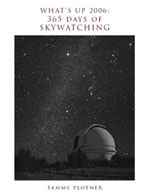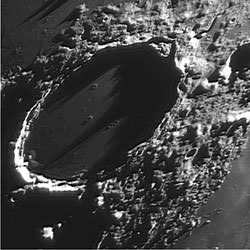
Download our free “What’s Up 2006” ebook, with entries like this for every day of the year.
|

Plato crater on the Moon. Image credit: Wes Higgins. Click to enlarge.
Monday, January 9 – Today in 1839, South African Thomas Henderson measured the distance to the closest bright star other than the Sun. Using geometrical parallax, Alpha Centauri was found to be 4.3 light-years away – this amounted to a distance of almost 41 trillion kilometers! Such a distance is the equivalent of over 270,000 earth-sun distances (astronomical units – AU).
Speaking of parallax, let’s take a look at a star with the precisely measured distance of 10.67 light-years from our Sun – Epsilon Eridani. Epsilon is the third closest of the visible stars and can be found tonight by starting at Rigel. About a hand span southwest, locate Gamma Eridani and head another fist-width northwest for a pair of easy stars. Epsilon is the westernmost.
At magnitude 3.7, Epsilon is not one of the brightest stars in the night sky because it has only 85% of the mass of our own Sun. It is also a young star, some 4 billion years younger than Sol and slightly variable. But, like our own “star,” Epsilon has no companion. On a curious note, science fiction chose Epsilon Eridani to be the home of the Vulcans!
Now let’s have a look at the Moon and a crater so prominent that it can be spotted unaided. To the lunar north, look for the dark ellipse of Plato. This mountain-walled plain with a dark floor is a Class V crater. Its slightly oval shape spans 64 by 67 miles in diameter, but appears far more elliptical due to its northern latitude. Plato’s floor is its most curious feature. Consisting of 2,700 square miles of unique lava, and only broken by a couple of very minor and supremely challenging craters, Plato is one of the very few areas on the lunar surface that seems to have changed in recent history.
Be sure to notice how close the Moon and Pleiades are tonight and check on the internet (IOTA) for grazing and occultation events visible from your area.
Tuesday, January 10 – Robert W. Wilson was born this day in 1936. Wilson is co-discoverer, along with Arno Penzias, of the cosmic microwave background and in 1978, won the Nobel Prize for Physics. On this day in 1946, the US Army’s Signal Corps became the first to successfully bounce radar waves off the Moon. Although this might sound like a minor achievement, let’s look just a bit further into what it really meant.
Known as “Project Diana,” scientists were hard at work to find a way to pierce the Earth’s ionosphere with radio waves – a feat believed impossible at the time. Headed by Lt. Col. John DeWitt, and working with only a handful of full-time researchers, a modified bedspring-type radar antenna was set up at Camp Evans, Georgia. Anxiously, the power was cranked up and the antenna aimed at the rising Moon. A series of radar signals were broadcast and echoes were picked up exactly 2.5 seconds later – the time it takes light to travel to the Moon and back. The significance of Project Diana cannot be underestimated. Because the ionosphere could be pierced, communications became possible between Earth and future space missions. Although it would be more than a decade before the first satellites and manned missions were launched into space, Project Diana had paved the way.
To commemorate Project Diana, let’s have a look at one of the most impressive craters on the Moon – Copernicus.
While Copernicus is not the oldest, deepest, largest, or brightest crater on the Moon, it certainly is one of the most detailed. Visible in binoculars toward Plato and near the terminator, this youthful crater gives a highly etched appearance. Its location in a fairly smooth plain near the center of the Moon’s disc, and prominent “splash” ray system, all combine to make Copernicus visually stunning in a small telescope.
Tonight let’s try our hand at splitting a double star – Gamma Arietis. Known as Mesarthim, Gamma is the third star in the line of bright stars – about a hand span west of the Pleiades – pointing in the direction of Eta Piscium. This orange and green pair gives the appearance of two glowing eyes in the night. Seeing two equal magnitude stars so close together can’t help but get you out observing – even when there’s Moon!
Wednesday, January 11 – Tonight in 1787, Sir William Herschel discovered Uranus’ largest moons – Oberon and Titania. Let’s have a look. Sixth magnitude Uranus is around two finder-widths south-southwest of Lambda Aquarii. Its small, pale blue disc will be distinguishable from neighboring stars. Under the right conditions, the planet can sometimes be seen unaided and was once given the designation “34 Tauri” by 17th century astronomer John Flamsteed. The two satellites – both 14th magnitude – can be seen with very large scopes with excellent seeing conditions.
The most outstanding feature on the northern lunar surface this evening is the “Bay of Rainbows” – Sinus Iridum. Take the time to power up and enjoy its many wonderful features including the bright Promontorium LaPlace to the northeast and Heraclides to the southwest. Ringed by the Juras Mountains, Sinus Iridum also includes crater Bianchini at center and Sharp to the west.
Thursday, January 12 – This date celebrates the 1830 founding of what – one year later – would become the Royal Astronomical Society. Conceived by John Herschel, Charles Babbage, James South and others, the RAS has continuously published its Monthly Notices since 1831.
Tonight our primary lunar study is crater Kepler. Look for it as a bright point, slightly lunar north of center near the terminator. Its home is the Oceanus Procellarum – a sprawling dark mare composed primarily of dark minerals of low reflectivity (albedo) such as iron and magnesium. Bright, young Kepler will display a wonderfully developed ray system. The crater rim is very bright, consisting mostly of a pale rock called anorthosite. The “lines” extending from Kepler are fragments that were splashed out and flung across the lunar surface when the impact occurred. The region is also home to features known as “domes” – seen between the crater and the Carpathian Mountains. So unique is Kepler’s geological formation that it became the first crater mapped by U.S. Geological Survey in 1962.
With the nearly full Moon in Gemini, go north to Cassiopeia and check out wide double star 35 Cassiopeia about two finger-widths west of Epsilon and an equal distance north of Gamma. This is an easy split for telescopes and can be resolved in steady binoculars.
Friday, January 13 – Tonight let’s give the Moon a rest and turn our scopes to Mars high overhead. With the exception of Sirius, Mars remains brighter than any star in the sky. To the eye, the planet’s ruddy glow makes it unmistakable. Through the telescope, observers can make out large-scale details such as the planets polar caps, Syrtis Major, Sinus Sabaeus, and the three major Mares – Cimmerium, Sirenum and Acidalium. Although good “seeing” makes high power and fine details possible, sometimes just “viewing” is half the fun!
Saturday, January 14 – Tonight’s Full Moon is known as the Wolf Moon. For the northern hemisphere in January, extreme cold and deep snows gave rise to the legend of wolf packs howling hungrily outside Indian villages. Sometimes the January Full Moon is also referred to as the Old Moon, or the Moon after Yule. No matter what it is called, it is still a lovely sight to watch rise and glide across the luminous night sky.
As a challenge this evening, try tracking down 5th magnitude double star Zeta Piscium. Located two finger-widths due east of Epsilon, this pair is easily resolved at low magnification due to its near matched brightness. Look for subtle shades of color displayed by the blue primary, and ivory-colored secondary.
Sunday, January 15 – With only short time before the Moon rises tonight, let’s start our evening by viewing a distant multiple star system – Sigma Orionis.
You’ll easily find 1400 light-years distant Sigma less than a finger-width below the left hand star in Orion’s “Belt” (Zeta or Alnitak). What won’t be easy is to distinguish the closest and brightest pair! 3.8 magnitude A and 6.6 magnitude B revolve around each other every 170 years and are separated by a close 0.3 arc seconds. Among the most massive binaries known, these two stars have extremely hot surfaces (approaching 50,000 degrees K) and both appear white in the eyepiece.
At a more comfortable separation, the white 8.8 magnitude C star resides 11.4 arc seconds southwest of the brighter pair. At a similar distance from AB to the east, look for red 6.7 magnitude D. Considerably further away at 41 arc seconds, the blue E star resides east-northeast of the AB primary. Unusual star E shares the same spectral qualities as the AB primary, yet is rich in helium light (emission lines) within its color spectrum. If five isn’t enough, then look 30 arc seconds southwest of E – because it, too, has a companion. All of these stars are part of the same physical system spanning about one-third of a light-year.
If you choose to look at the lunar surface, carefully check along the eastern edge where the terminator is now receding. In the north, look for the dark shades of Mare Humboldtianum and the equally dark floor of crater Endymion to its west. This lava filled area is around 70 miles in diameter.
I would personally like to thank all of you for your support and kind comments on the look at the year ahead. Be sure to stay tuned to the weekly column as breaking observing news is added. Until next week, ask for the Moon, but keep reaching for the stars! May all of your journeys be at light speed… ~Tammy Plotner
